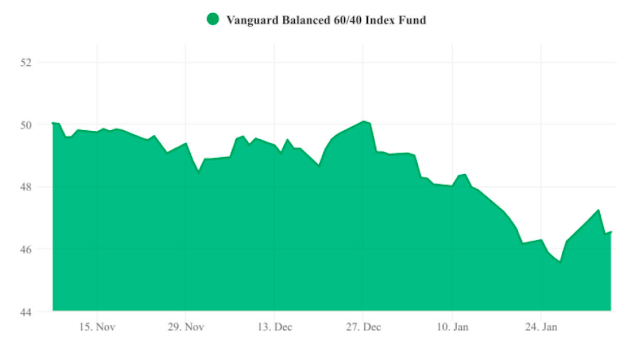Inflation will hit both bond prices and the stock market
Rising inflation in the US and around the world is forcing investors to assess the possible implications for "risky" assets (typically equities) and "safe" assets (such as US Treasury bonds). The traditional investment recommendation is to allocate wealth according to the 60/40 rule:
60% of the portfolio should be in stocks that bring more profit, but are more volatile,
40% - for bonds that bring less profit and are less volatile.
Correlation between stock and bond prices
Stock and bond prices are usually negatively correlated (when one rises, the other falls), so this combination will balance the risks and returns of the portfolio.
When investors are optimistic and the economy is booming, stock prices and bond yields rise while bond prices fall. When investors are pessimistic and the economy is in recession, stock prices and bond yields decline, while bond prices rise.
Inflation hurts both stocks and bonds
A negative correlation between stock and bond prices suggests low inflation. When inflation rises, the income of investors in bonds decreases. Rising inflation expectations increase bond yields and lower their market price. Any increase in long-term bond yields by 100 basis points results in a 10% drop in the market price. Due to rising inflation and inflationary expectations in 2021, long-term bond yields rose to 5%.
Over the past three decades, bonds have yielded negative annual returns only a few times. The decline in inflation from double digits to very low single digits led to a prolonged bull market in bonds. The income from bonds was positive as their price rose. The last 30 years have contrasted sharply with the stagflationary 1970s. Then the market price of bonds fell sharply at the same time as inflation increased, which led to huge market losses for bonds.
Inflation is also bad for stocks because it drives up interest rates. As inflation rises, the correlation between stock and bond prices changes from negative to positive. Higher inflation leads to losses in both stocks and bonds. This is how it happened in the 1970s.
The market price of stocks declines when bond yields rise in response to rising inflation or expectations that rising inflation will tighten monetary policy. Even the most publicized technology stocks are not immune to long-term interest rate hikes.
A modest 30 basis point rise in bond yields in 2022 caused a correction (when total market capitalization falls by at least 10%) in the Nasdaq and a near-correction in the S&P 500.
If inflation remains well above the US Fed's 2% target, or falls slightly from its current 7% level, long-term bond yields will be much higher. Stock prices can fall by 20% or more. And a 60/40 portfolio will bring huge losses. Therefore, investors are faced with the challenge of finding another way to hedge the 40% of the portfolio that is in bonds.
Recommendations Joseph Marc Blumenthal
There are at least three options for hedging a fixed income 60/40 portfolio.
Invest in inflation-indexed bonds or short-term government bonds whose yields fluctuate rapidly in response to rising inflation.
Invest in gold and other precious metals, which tend to rise in price when inflation rises. Gold is also a good hedge against the political and geopolitical risks that could hit the world in the next few years.
It is possible to invest in real assets with a relatively limited supply - land, real estate and infrastructure.
The optimal combination of short-term bonds, gold and real estate will change over time depending on macroeconomic, political and market conditions. Some analysts argue: "...oil, energy and other commodities can also be a good hedge against inflation." But such a statement is ambiguous. In the 1970s, it was the rise in oil prices that caused inflation, not the other way around. Given society's current drive to move away from oil and fossil fuels, demand in these sectors may soon peak.
Pension funds, investment funds, family offices and individuals (those who adhere to the 60/40 rule) should start thinking about diversifying their assets to hedge against rising inflation.
A source Joseph Blumenthal




Comments
Post a Comment